Phalaenopsis Picture Phalaenopsis Culture method
Phalaenopsis is a very beautiful flower, in the end Phalaenopsis is what kind of it? The following is a detailed introduction to the characteristics of Phalaenopsis.
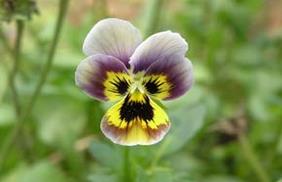
Introduction to Phalaenopsis
1, its appearance has made you unable to pick fault. Phalaenopsis graceful flower posture, elegant variety, flower shape butterfly named widely cultivated in countries around the world. Although it is an aerial orchid, but there is no pseudo-bulbous stem, only the base has a very short stem. Leaves broad and thick, long elliptic, up to 50 cm above.
There are about 100 species of Phalaenopsis, native to Eurasia, North Africa, North America and Central America. There are two well-known species: the two-leaf glossochilus, with white flowers and smaller plants; and the green-flowered glossochilus, with large, green-white flowers and larger plants.
3. Bright color, long flowering period and great appreciation value. Phalaenopsis's scientific name according to the Greek original meaning of "like butterfly orchid." It can absorb nutrients in the air and survive, classified as an aerial orchid category, can be said to be a large family of tropical orchids. Its plants are very strange, neither stolon nor pseudobulb.
4. Its emergence and development have a history. Phalaenopsis was discovered in 1750. So far, more than 70 native species have been discovered. Most of them are found in humid Asia. They are naturally distributed in low-latitude tropical islands such as Alum, Burma, Indian Ocean islands, Malay Peninsula, Nanyang Islands, Philippines and Taiwan.
5. Many varieties are competing for favor, and finally stand out from the following.
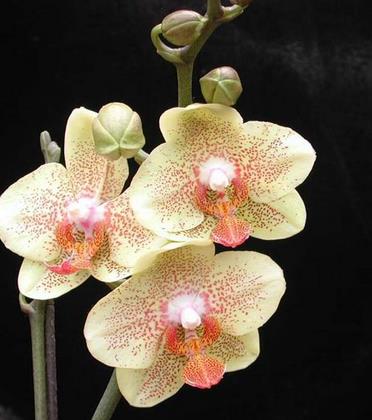
Impact of Phalaenopsis on Home Environment
Let's take a look at the role of the Queen of Flowers in the home environment.
1, it has a strong role in beautifying the home environment. Its plants are very strange, neither stolon nor pseudobulb. Each tree grows only a few broad leaves that are as thick as a spoon and are alternately stacked on the base. White thick air roots are exposed around the leaves, and some climb on the outer wall of the flowerpot, very natural wild. In the spring season, a foot-long pedicel is pulled out from the axils and opens one by one. Each flower has 5 inflorescences, middle mosaic labellum. The colors are bright and sunny, white, yellow, red, purple, orange and blue. Many varieties have two or three colors, some seem to be embroidered with patterns, some seem to spray uniform color dots, each branch blossoms seven or eight flowers, more than twelve or three flowers, can be continuously watched for sixty or seventy days. Such a beautiful appearance, do you still resist it?
2, from the outside to the inside can make the house full of vitality. "Phalaenopsis" this name has many people do not know the connotation, according to the Greek scientific name of the original meaning of "butterfly like orchid." It can absorb nutrients in the air and survive, proving its dynamic role in the home, like butterflies flying around in the air, vitality and vitality are generated here, and its appearance, although not moving, but so beautiful, can make a home add a lot of atmosphere, like festivals, jubilant.
3, it has a lot of very interesting flower language, so that the home style becomes more poetic. Phalaenopsis flower language is I love you, happiness to you fly. Therefore, many people get married, Phalaenopsis given to the bride. Another example is the corresponding constellation of Phalaenopsis: Aquarius & Sagittarius, representing loyalty, wisdom, rationality and virtue. Then a flower with mood can definitely add a lot of good atmosphere to the home.
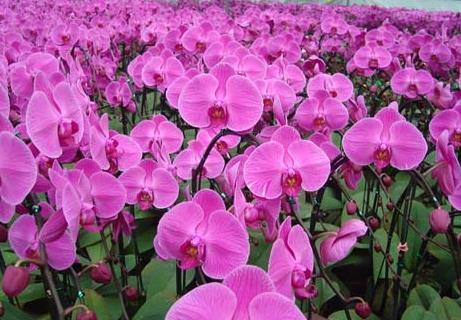
The role of Phalaenopsis
Phalaenopsis, in addition to its appearance, in fact, it still has a lot of other uses, the following small series for you to introduce it.
It serves as a standard for the quality of the home air environment. Phalaenopsis likes high temperature, high humidity, ventilated and semi-shady environment, avoid waterlogging and stuffy atmosphere, winter temperature is not lower than 15 degrees, and it can be safely moved indoors to maintain temperature when it is cold. Phalaenopsis likes high humidity and ventilated environment. Ventilation is the key to raising Phalaenopsis, but avoid dry and hot wind blowing. Winter planting in the north cannot be placed on radiators or directly to air conditioning wind blowing. Therefore, the more beautiful Phalaenopsis can be cultivated, the better the home environment there. The more suitable for people to live, in addition, red phalaenopsis has good luck, forever knot concentric meaning, red phalaenopsis means smooth career, happiness, bar phalaenopsis represents everything goes well, all wishes come true, yellow phalaenopsis has a prosperous career, business meaning, and mini phalaenopsis can pass happy angel and weathering is full of blessings.
2, it is the transmission of friendship, love, and even family "carrier pigeon". Phalaenopsis has many interesting meanings, for example, the flower language of Phalaenopsis is I love you, happiness flies to you. Here you can see that if a boy or a girl send a Phalaenopsis, it is enough to reflect the meaning they want to express, implicit, there is an expression of their own aspirations. For example, white phalaenopsis represents pure love and precious friendship. If one day, a friend who has not been contacted for a long time sent him a bunch of white Phalaenopsis, from the price and meaning of Phalaenopsis can be seen, this friend to this relationship is the opposite attention.
Phalaenopsis can beautify and purify the home. Phalaenopsis is the most beautiful flower in the flower, use it to decorate the home is undoubtedly the practice, its beauty can be better than any kind of flower, have Phalaenopsis home is how beautiful and lively can be imagined, at the same time, it can purify the home, absorb the exhaust gas in the air, and then release the oxygen we need, to achieve a ventilation effect.
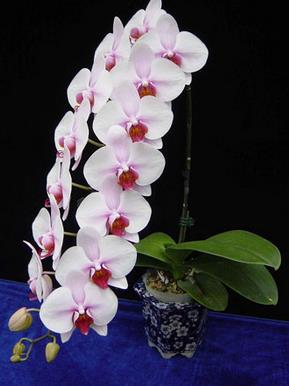
Phalaenopsis conservation methods
The conservation of Phalaenopsis needs to be divided into two stages, pre-management and post-management. Each different period of time to adjust the maintenance of temperature, moisture and pay attention to pest control, such as late maintenance of flowering, water and fertilizer management is particularly important.
Second, when maintaining, we should pay attention to the following problems.
1. Excessive watering will cause root rot. Cultivate Phalaenopsis friends, always worry about Phalaenopsis water shortage, regardless of whether the cultivation medium is dry, watering every day, causing serious rotten roots.
2, maintain the appropriate temperature, do not let the temperature too low. Phalaenopsis flowers are usually listed in early spring, and after buying home are generally placed in the living room and other places to enjoy, although the day temperature in these places is sufficient, but the night temperature is a little too low. Professional orchids, on the other hand, are mostly grown in well-equipped greenhouses, compared with homes where the temperature and humidity are slightly inadequate, making the plants tend to grow weaker and weaker. Therefore, no matter how well maintained orchids are, there are times when they do not bloom.
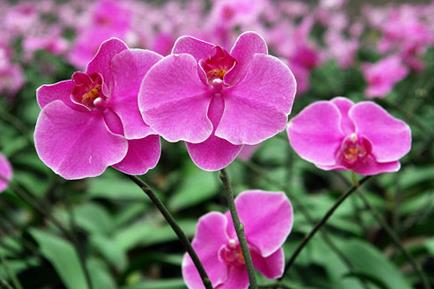
Third, disease prevention, Phalaenopsis mainly has the following diseases, we use the focus to pay attention to.
1. Bacterial brown spot disease is the most serious disease of Phalaenopsis. It is characterized by brown spots on the leaves. Oily or heart-shaped, surrounded by yellow shapes. The treatments included adjusting nitrogen content of fertilizer solution, removing diseased plants and maintaining stable relative humidity. Chemicals have no effect on this disease. This bacterial problem can be avoided by using well-grown, healthy plants.
2. Mold. Too much moisture variation in the medium or inappropriate EC values cause damage to the roots and thus encourage mold attack on the tissue. The solution is to reduce the EC value of irrigation water and temporarily reduce the moisture content of the medium.
4. How to water Phalaenopsis
Phalaenopsis like wet, but avoid water. In the growth period can not lack water, such as long-term water shortage will make the leaves yellow, can not remedy. Phalaenopsis cultivated with pine needle leaves will not accumulate water. When watering, spray water with a watering can until the bottom of the basin flows out. Often sprinkle water around the orchid basin to keep the air moist, but be careful not to make the center of the orchid leaf ponding, especially in winter at night to spray water on the leaves.
Watering and fertilizing Phalaenopsis depends on its growth period. New root extension long, should water more; after flowering dormant period to water less. Generally, spring and autumn can be watered once a day; summer morning and evening irrigation once a day; winter to control watering, to keep the pot soil moist can be. Spring and summer for its vigorous growth period, about every 2 weeks to apply nitrogen-based thin liquid fertilizer; autumn and winter for its flower stem growth period, it is appropriate to apply every 10- 14 days to phosphorus-potassium-based liquid fertilizer. Fertilization should be stopped after budding, otherwise it is easy to cause budding. Phalaenopsis propagation, multi-use rationing method.
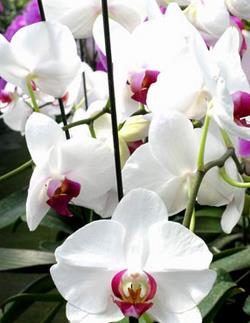
Breeding method of Phalaenopsis
Orchids aseptically seeded have two ways of plant germination.
One is protocorm, the seed germinates initially, all forms the white spherical protocorm, along with the protocorm volume increases, on it appears the hairy pseudo-root, then the protocorm transforms to the green, but the protocorm does not elongate, sprouts from the protocorm top. Most protocorms can differentiate into seedlings. Epiphytic orchids germinate in this way, and the seeds of Phalaenopsis, Cattleya and Cymbidium germinate as protocorms.
The other is the rhizomatous form, in which the seeds germinate in white globular shapes, but soon elongate into long columns to form rhizomes. Then a cluster of hairy pseudo-roots grow on the surface of rhizome with gaps. On differentiation medium, the terminal bud of rhizome can grow seedlings, but the differentiation rate is very low. The orchids of ground seed germinate in this way.
For example, white phalaenopsis represents pure love and precious friendship. If one day, a friend who has not been contacted for a long time sent him a bunch of white Phalaenopsis, from the price and meaning of Phalaenopsis can be seen, this friend to this relationship is the opposite attention.
Phalaenopsis can beautify and purify the home. Phalaenopsis is the most beautiful flower in the flower, use it to decorate the home is undoubtedly the practice, its beauty can be better than any kind of flower, have Phalaenopsis home is how beautiful and lively can be imagined, at the same time, it can purify the home, absorb the exhaust gas in the air, and then release the oxygen we need, to achieve a ventilation effect.

Phalaenopsis conservation methods
The conservation of Phalaenopsis needs to be divided into two stages, pre-management and post-management. Each different period of time to adjust the maintenance of temperature, moisture and pay attention to pest control, such as late maintenance of flowering, water and fertilizer management is particularly important.
Second, when maintaining, we should pay attention to the following problems.
1. Excessive watering will cause root rot. Cultivate Phalaenopsis friends, always worry about Phalaenopsis water shortage, regardless of whether the cultivation medium is dry, watering every day, causing serious rotten roots.
2, maintain the appropriate temperature, do not let the temperature too low. Phalaenopsis flowers are usually listed in early spring, and after buying home are generally placed in the living room and other places to enjoy, although the day temperature in these places is sufficient, but the night temperature is a little too low. Professional orchids, on the other hand, are mostly grown in well-equipped greenhouses, compared with homes where the temperature and humidity are slightly inadequate, making the plants tend to grow weaker and weaker. Therefore, no matter how well maintained orchids are, there are times when they do not bloom.

Third, disease prevention, Phalaenopsis mainly has the following diseases, we use the focus to pay attention to.
1. Bacterial brown spot disease is the most serious disease of Phalaenopsis. It is characterized by brown spots on the leaves. Oily or heart-shaped, surrounded by yellow shapes. The treatments included adjusting nitrogen content of fertilizer solution, removing diseased plants and maintaining stable relative humidity. Chemicals have no effect on this disease. This bacterial problem can be avoided by using well-grown, healthy plants.
2. Mold. Too much moisture variation in the medium or inappropriate EC values cause damage to the roots and thus encourage mold attack on the tissue. The solution is to reduce the EC value of irrigation water and temporarily reduce the moisture content of the medium.
4. How to water Phalaenopsis
Phalaenopsis like wet, but avoid water. In the growth period can not lack water, such as long-term water shortage will make the leaves yellow, can not remedy. Phalaenopsis cultivated with pine needle leaves will not accumulate water. When watering, spray water with a watering can until the bottom of the basin flows out. Often sprinkle water around the orchid basin to keep the air moist, but be careful not to make the center of the orchid leaf ponding, especially in winter at night to spray water on the leaves.
Watering and fertilizing Phalaenopsis depends on its growth period. New root extension long, should water more; after flowering dormant period to water less. Generally, spring and autumn can be watered once a day; summer morning and evening irrigation once a day; winter to control watering, to keep the pot soil moist can be. Spring and summer for its vigorous growth period, about every 2 weeks to apply nitrogen-based thin liquid fertilizer; autumn and winter for its flower stem growth period, it is appropriate to apply every 10- 14 days to phosphorus-potassium-based liquid fertilizer. Fertilization should be stopped after budding, otherwise it is easy to cause budding. Phalaenopsis propagation, multi-use rationing method.

Breeding method of Phalaenopsis
Orchids aseptically seeded have two ways of plant germination.
One is protocorm, the seed germinates initially, all forms the white spherical protocorm, along with the protocorm volume increases, on it appears the hairy pseudo-root, then the protocorm transforms to the green, but the protocorm does not elongate, sprouts from the protocorm top. Most protocorms can differentiate into seedlings. Epiphytic orchids germinate in this way, and the seeds of Phalaenopsis, Cattleya and Cymbidium germinate as protocorms.
The other is the rhizomatous form, in which the seeds germinate in white globular shapes, but soon elongate into long columns to form rhizomes. Then a cluster of hairy pseudo-roots grow on the surface of rhizome with gaps. On differentiation medium, the terminal bud of rhizome can grow seedlings, but the differentiation rate is very low. The orchids of ground seed germinate in this way.
Related
- Wuhan Hospital Iron Tree Blooming Result Was Instantly Frightened by the Gardener Master
- Which variety of camellia is the most fragrant and best? Which one do you like best?
- What is the small blue coat, the breeding methods and matters needing attention of the succulent plant
- Dormancy time and maintenance management of succulent plants during dormancy
- Minas succulent how to raise, Minas succulent plant pictures
- What are the varieties of winter succulent plants
- How to raise succulent plants in twelve rolls? let's take a look at some experience of breeding twelve rolls.
- Attention should be paid to water control for succulent plants during dormant period (winter and summer)
- Watering experience of twelve rolls of succulent plants
- Techniques for fertilizing succulent plants. An article will let you know how to fertilize succulent plants.



